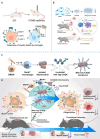Generation and clearance of myelin debris after spinal cord injury
- PMID: 40313091
- PMCID: PMC12407535
- DOI: 10.4103/NRR.NRR-D-24-01405
Generation and clearance of myelin debris after spinal cord injury
Abstract
Traumatic spinal cord injury often leads to the disintegration of nerve cells and axons, resulting in a substantial accumulation of myelin debris that can persist for years. The abnormal buildup of myelin debris at sites of injury greatly impedes nerve regeneration, making the clearance of debris within these microenvironments crucial for effective post-spinal cord injury repair. In this review, we comprehensively outline the mechanisms that promote the clearance of myelin debris and myelin metabolism and summarize their roles in spinal cord injury. First, we describe the composition and characteristics of myelin debris and explain its effects on the injury site. Next, we introduce the phagocytic cells involved in myelin debris clearance, including professional phagocytes (macrophages and microglia) and non-professional phagocytes (astrocytes and microvascular endothelial cells), as well as other cells that are also proposed to participate in phagocytosis. Finally, we focus on the pathways and associated targets that enhance myelin debris clearance by phagocytes and promote lipid metabolism following spinal cord injury. Our analysis indicates that myelin debris phagocytosis is not limited to monocyte-derived macrophages, but also involves microglia, astrocytes, and microvascular endothelial cells. By modulating the expression of genes related to phagocytosis and lipid metabolism, it is possible to modulate lipid metabolism disorders and influence inflammatory phenotypes, ultimately affecting the recovery of motor function following spinal cord injury. Additionally, therapies such as targeted mitochondrial transplantation in phagocytic cells, exosome therapy, and repeated trans-spinal magnetic stimulation can effectively enhance the removal of myelin debris, presenting promising potential for future applications.
Keywords: foam cells; lipid droplets; lipid metabolism; macrophages; microglia; myelin debris; myelin proteins; myelin sheath; nerve regeneration; phagocytosis; spinal cord injury.
Copyright © 2025 Neural Regeneration Research.
Conflict of interest statement
Figures





References
-
- Abbott NJ, Rönnbäck L, Hansson E. Astrocyte-endothelial interactions at the blood-brain barrier. Nat Rev Neurosci. 2006;7:41–53. - PubMed
-
- Aggarwal S, Yurlova L, Simons M. Central nervous system myelin: structure, synthesis and assembly. Trends Cell Biol. 2011;21:585–593. - PubMed
-
- Ahuja CS, Wilson JR, Nori S, Kotter MRN, Druschel C, Curt A, Fehlings MG. Traumatic spinal cord injury. Nat Rev Dis Primers. 2017;3:17018. - PubMed
LinkOut - more resources
Full Text Sources

